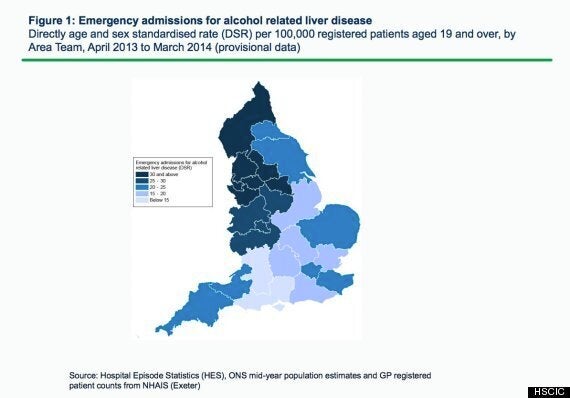Places in the UK with the highest rates of people admitted to hospital for alcohol-related liver disease have been mapped out by health officials, in a bid to "paint a powerful picture of one of the many impacts that alcohol has on patients and the NHS in this country."

The North West and the North East were pinpointed to be the places with the highest hospital admissions, according to the map created by the Health and Social Care Information Centre (HSCIC).
Bath, Gloucestershire, Swindon and Wiltshire had the lowest emergency admission rates for the condition which refers to liver damage caused by alcohol misuse.
Death rates linked to alcohol-related liver disease have risen "considerably" over the last few decades, according to the NHS.
Health service guidance suggests the most effective way to prevent the condition is to stop drinking or stick to the recommended daily limits, with at least two alcohol-free days a week.
Nationally hospitals admitted 10,500 cases of alcohol-related liver disease between April 2013 and March 2014, according to HSCIC.
SEE ALSO:
This Interactive Online Map Shows Which Countries Drink The Most Alcohol (And Which Don't)
Wondering If You Have A Problem With Alcohol? These Two Questions May Determine That
The map shows rates of regional emergency admissions for every 100,000 people living in each area during this timeframe.
The place with the highest rate of admissions was Greater Manchester where 45.8 people out of every 100,000 living in the region were admitted as an emergency.
In Merseyside there were 41.3 admissions per every 100,000 people and in Lancashire there were 38.9 admissions per 100,000 of the population.
The places with the lowest rates of admissions were Bath, Gloucestershire, Swindon and Wiltshire where hospitals in the regions admitted 14.7 people out of every 100,000 people.
HSCIC chairman Kingsley Manning said: "This map paints a powerful picture of one of the many impacts that alcohol has on patients and the NHS in this country."
Story continues below...
Jackie Ballard, chief executive of charity Alcohol Concern, said: "These figures show that the problems caused by alcohol misuse are continuing to put an increasing strain on our NHS.
"More than half of those who drink do so at risky levels and these figures show it isn't just binge drinking youngsters but middle-aged, and often middle class drinkers who are regularly drinking above recommended limits. It's this regular drinking of a bit too much too often that stores up all sorts of health problems.
"Unless we start taking this seriously and acknowledge the health problems too much alcohol can cause, the situation will only get worse."
A Department of Health spokeswoman said: "We are taking action to reduce excessive alcohol consumption and to give people better information about the impact drinking can have on health.
"To help tackle regional variations in emergency admissions for alcohol related liver disease, we've given local authorities £8.2 billion in ring-fenced funding over three years so they can address issues like alcohol misuse in their areas."
